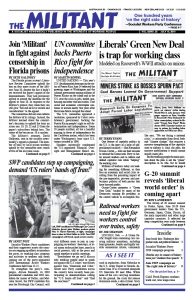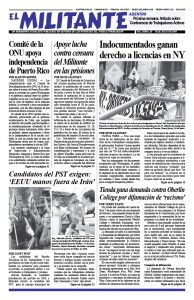The Group of 20 annual summit in Osaka, Japan, June 28-29 drew government leaders from the U.S., Germany, Japan, China, Russia, all the main imperialist and other large capitalist countries. It reflected the deep competition over trade between them, despite pretensions of global economic cooperation. These conflicts illustrate the crisis wracking capitalist production and trade today. The final G-20 statement said that global growth was “low,” with geopolitical risks “tilted to the downside.”
The post-World War II imperialist world order is slowly but surely being torn apart by the workings of capitalism itself.
At the gathering, President Donald Trump met on the sidelines with Chinese President Xi Jinping, and afterwards traveled to the North Korean border to meet with the Democratic People’s Republic of Korea leader Kim Jong Un. Stalled trade talks with Beijing were resurrected, and talks with the DPRK over nuclear disarmament put back on the table.
The U.S. capitalist class is using its unequaled economic weight — the size of its domestic market, the centrality of its financial system and the ever-present U.S. dollar as the world’s reserve currency — to protect its exploitative global domination against continuing decline. Even though the dollar’s share of global foreign exchange has slipped since the financial crisis a decade ago, it is still 62%, dwarfing all rivals.
In his G-20 address June 29, Xi, in a veiled reference to the Trump administration’s escalation of tariffs, denounced protectionism by rich countries as “destroying the global trade order.”
Trump says the “globalized” economic order has aided the rise of Chinese capitalism in recent decades to the detriment of U.S. capitalism. Trump and Xi met over lunch at the G-20 to restart bilateral trade talks. The U.S. president agreed to lift his threat of new duties on $300 billion of Chinese goods not currently hit by 25% tariffs. He also lifted a ban on U.S. companies selling high-tech parts to Chinese telecom giant Huawei, part of a broader battle over market share between Chinese and U.S. tech bosses and their state backers.
In return, Xi promised to buy more U.S. agricultural goods. Just before the meeting, Beijing ordered an additional half a million tons of U.S. soybeans. The two presidents agreed to hold further talks. Stocks and futures markets rallied on the news, and China’s currency, the renminbi, strengthened.
Since the end of the second world war, the U.S. rulers have been the top imperialist world power — including in the Pacific. The Chinese capitalist rulers are expanding rapidly today, setting up military bases throughout the Western Pacific, reaching into new markets internationally and developing a more advanced army and navy.
In the absence of a revolutionary working-class upsurge, the Chinese capitalists look to the future and see themselves as the inevitable new top dog.
As the conference was taking place, the confrontation pitting Beijing and its ally Hong Kong Chief Executive Carrie Lam against millions of working people in Hong Kong continued to play out. On July 1, the 22nd anniversary of the handover of the British colony to China, hundreds of thousands marched in the streets, calling for the pro-Beijing government to resign. A few hundred protesters occupied and trashed Hong Kong’s legislature, clashing with police. This gave Beijing an unaccustomed chance to pose as a guardian of “the rule of law.”
Mass protests continue in Hong Kong
The Chinese rulers blamed unnamed foreign countries for the unrest, while admitting the huge marches were a “blatant challenge” to Beijing’s rule. But what they really fear is the “interference” of the class struggle from within, a fear shared by rival ruling classes around the world.
Following the G-20 summit, Trump became the first sitting U.S. president to visit North Korea June 30. He stepped across the line in a surprise meeting with Kim at the heavily fortified zone dividing the peninsula. South Korean President Moon Jae-in joined them for a brief but unprecedented address to the press.
Despite massive devastation inflicted on the Korean people following the U.S. rulers’ seizure of southern Korea at the end of World War II, and in the North during the 1950-53 Korean War, U.S. imperialism failed to crush the workers and peasants government that arose out of the 1946 revolution in the North. Ever since, Washington has refused to sign a peace treaty.
Achieving a drawdown of nuclear weapons on the peninsula would be a gain for all working people.
Continued conflict in Middle East
Nowhere are the instabilities tearing apart the old imperialist world order more apparent than in the Middle East. The White House threatened military retaliation after an Iranian missile downed a U.S. drone June 20. New troop reinforcements were sent to reinforce Washington’s already massive military presence in the region, and the U.S. rulers tightened their harsh sanctions that have increased the economic burden on Iranian working people.
Trump told the press June 28 he’s in “no rush” to ease tensions with Iran. On July 1 Tehran announced they have reached the 660 pound “limit” for stocks of enriched uranium set by the 2015 nuclear deal abandoned by Washington. The capitalist rulers in Iran are seeking to pressure France, Germany and Britain, who also signed the treaty, to find a way to engage in trade, offering relief from Washington’s sanctions. The European rulers said they would be “patient” with Tehran, the Wall Street Journal reported July 3.
The Israeli rulers, however, responded to Tehran’s move with air strikes July 2 from Lebanese airspace on Iranian-linked military bases in Syria.

